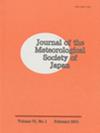Structure and Evolution of a Convective System with Bow Echo Associated with Terrain on Jeju Island, Korea
IF 1.6
4区 地球科学
Q3 METEOROLOGY & ATMOSPHERIC SCIENCES
引用次数: 2
Abstract
On July 13, 2012, a bow echo was observed over the lee side of the Mt. Halla (1,950 m above sea level) on Jeju Island, Korea. Three-dimensional (3D) wind-field and surface observation analyses were carried out to understand the structure and evolution of convective systems with a bow echo on a bell-shaped terrain. A northeastward-moving convective system passed over the approximately bell-shaped isolated mountain with a mean speed of 17 m s. On the windward side of the mountain, the convective system developed by the inflow of unstable warm air from the ocean and terrain-induced upward motion, even with a low convective available potential energy value of 511 J kg. When passing the lee side of the mountain, a bow echo was formed in the convective system by the strongest winds behind the bow echo. Behind the leading edge of the bow echo, the strengthened rear-inflow jet descended with relatively dry air along the surface, resulting in enhancing evaporative cooling. The precipitation-induced downdrafts generated a cold pool on the lee side of the mountain. The development of an rear-inflow jet and cold pool formation both contributed to the evolution of the bow echo. In addition, the isolated bell-shaped terrain had a major indirect influence on the evolution of the convective system with a bow echo in this event.韩国济州岛地形与弓形回波对流系统的结构和演化
2012年7月13日,在济州岛汉罗山背风面(海拔1950米)观测到弓形回波。通过三维风场和地面观测分析,了解了钟形地形上弓形回波对流系统的结构和演化。一股向东北移动的对流系统以17 m s的平均速度掠过近钟形孤立山。在山的迎风侧,对流系统由海洋不稳定暖空气流入和地形诱导的上升运动发展而来,对流有效位能较低,为511 J kg。当经过山的背风面时,弓形回波背后最强的风在对流系统中形成弓形回波。在弓形回波前缘后,增强的后流入射流带着表面相对干燥的空气下降,导致蒸发冷却增强。降水引起的下降气流在山的背风面形成了一个冷池。后入流射流的发展和冷池的形成都促进了弓形回波的演化。此外,孤立的钟形地形对弓形回波对流系统的演化具有重要的间接影响。
本文章由计算机程序翻译,如有差异,请以英文原文为准。
求助全文
约1分钟内获得全文
求助全文
来源期刊
CiteScore
6.70
自引率
16.10%
发文量
56
审稿时长
3 months
期刊介绍:
JMSJ publishes Articles and Notes and Correspondence that report novel scientific discoveries or technical developments that advance understanding in meteorology and related sciences. The journal’s broad scope includes meteorological observations, modeling, data assimilation, analyses, global and regional climate research, satellite remote sensing, chemistry and transport, and dynamic meteorology including geophysical fluid dynamics. In particular, JMSJ welcomes papers related to Asian monsoons, climate and mesoscale models, and numerical weather forecasts. Insightful and well-structured original Review Articles that describe the advances and challenges in meteorology and related sciences are also welcome.

 求助内容:
求助内容: 应助结果提醒方式:
应助结果提醒方式:


